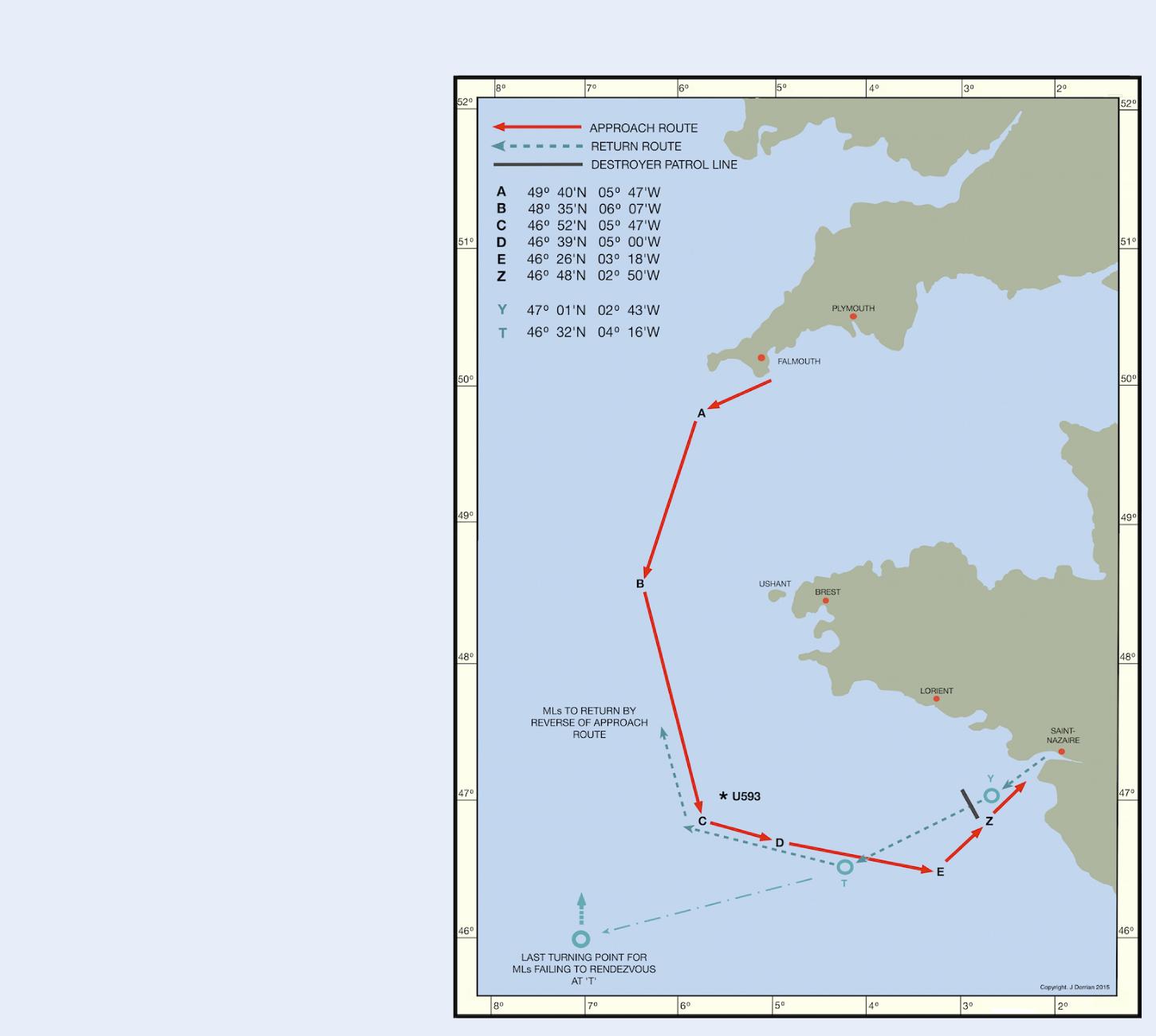 |
|
The Voyage to Saint-Nazaire
12.30hrs: Thursday March 26th, 1942. The receipt of the executive order CARRY OUT CHARIOT from Admiral Forbes' HQ signifies the official start of the raid. The small boats sail from Falmouth, followed by the destroyers Campbeltown, Tynedale and Atherstone. Once together they form up into three columns and sail south-west towards Position A at 13kts, with a single fighter patrolling overhead. Once clear of land the ships adopt the disguise of an anti-submarine sweep.
19.11hrs: The ships reach position A and alter to slightly west of south. With dusk approaching, their fighter escort makes for home. Ryder orders a formation change to Night Cruising Order. Speed now 14kts.
23.00hrs: Position B is reached. Their course is now beginning to take the ships directly into enemy waters and across the U-Boat transit routes between the broader Atlantic and their home bases of Brest, Lorient and Saint-Nazaire. They are also within range of German airfields in northern Brittany.
During the early hours of the morning a close watch is kept for U-Boats, with Lieutenant Platt, RNR, in ML 447 mistakenly reporting a sighting at 02.14hrs. At dawn the three destroyers hoist German Ensigns, while in the Coastal Forces ships the White Ensigns are hauled down and stowed.
07.00hrs: Friday March 27th, 1942. At Position C the force turns to port, onto course 112 degrees. Speed is reduced to just 8kts, and the anti-submarine sweep formation is adopted once more in case the ships might be under observation - which they are, from the conning tower of U-593, returning damaged from patrol, destination also Saint-Nazaire. Once sighted and identified the U-Boat is attacked, fire being opened by HMS Tynedale - with White Ensign now flying - at 07.45hrs. The U-Boat submerges and the destroyers Tynedale and Atherstone sail south-west for a period, to conceal their true course - just in case.
By 11.00hrs the flap is over, and the reconstituted fleet resumes its south-easterly course.
Circa Noon: in the area of position D, French trawlers, any one of which might be carrying a wireless or German observer, are sighted. One of these, Nungesser et Coli, F.267, is approached and sunk after her crew are taken on board Tynedale.
14.00hrs: With the British ships now well to the south-east of his position, Kapitanleutnant Gerd Kelbling, the commander of U-593 finally surfaces. He radios a sighting report to HQ, giving the British course as westerly, based on the destroyers' intentional diversion after forcing him to dive. Unbelievably the one major sighting of the Chariot force now interprets its course as AWAY from Saint-Nazaire rather than TOWARDS it. As a consequence of the erroneous report six German destroyers, whose presence in port could have had disastrous consequences for the complex demolition plans, were instead ordered to sea, on a fruitless search mission.
20.00 hrs: The British ships reach position E, and stop. Ryder and Newman transfer from Atherstone to MGB 314, and the force adopts its attack formation of port and starboard columns of MLs with Campbeltown in between. A north easterly course is now adopted, heading for the mouth of the River Loire at 15kts.
22.00hrs: Position Z is reached and their course is confirmed as correct by signal from the partially submerged HMSub Sturgeon acting as navigation beacon. With only 40 miles to go to target, the destroyers Tynedale and Atherstone detach to patrol a line where they might best hope to rendezvous with surviving launches coming out of the estuary. Sturgeon too departs, to resume her interrupted patrol off Brest.
00.25: Saturday March 28th. The ships pass the wreck of the troopship Lancastria, sunk in 1940. They are on time, and on course: now a mere 11 miles from the 'Normandie' Dock - and still undiscovered by the port's defenders.
All material contained in this site is subject to copyright and must not be reproduced in any format without the consent of the relevant copyright holder